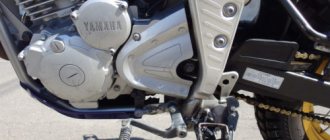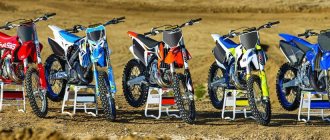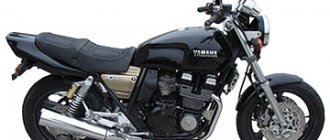Bike features
Here are the main features of the motorcycle:
- design complexity;
- ease of landing;
- pronounced atypicality.
It is very difficult to repair the model yourself, since even in order to change the battery, you will have to remove a considerable amount of plastic. This is the price to pay for versatility. However, this is not such a major drawback as to put an end to the motorcycle.
Yamaha TDM 850 owner review.
My acquaintance with touring enduros took place when I decided to exchange my Yamaha Virago 1100 chopper for an old Yamaha TDM 850. I wanted more power and normal suspensions, but the chrome and roar of a forward flow never attracted me, so I gave up on the ad with the seller of motorcycles, the key for key. I got a first generation motorcycle, with two round headlights at the front, just like I wanted. Externally it reminded me of the Honda Africa Twin.
The first impression is very positive - vigorous acceleration, excellent brakes, the seat is comfortable, the steering is also excellent, the shock absorbers are such that you can drive on broken asphalt and even drink coffee while driving without the risk of spilling it. True, the impression soon turned out to be spoiled by the age-related sores of the motorcycle - after all, a couple of decades of age is not a joke. As I learned the hard way, the first TDM 850s really like to eat oil along with gasoline. This is true, at least it’s good that the oil doesn’t all splash around in the crankcase - it’s in the oil tank, and you can fill it there with a reserve without risk to the engine.
If you drive calmly and not fast, then from replacement to replacement it took a liter and a half to two, but this can also be attributed to piston wear, since the motorcycle is still old, and who knows how much mileage it actually had at that time the moment when he came to me. But if you drive at 200 km/h, the oil begins to drain the same two liters, but for a thousand kilometers, which I was surprised to discover after a trip to the sea. That’s how I drove – topping up periodically, since I was turning the engine of the two-wheeled pensioner mercilessly.
But despite its age, the TDM 850 coped with its tasks really well. You can safely drive on it on asphalt, which was last repaired half a century ago, practically without slowing down. Moving from the asphalt onto the dirt is also never a problem; here it all comes down to the tires. You can ride on dry ground without any problems, but in mud or wet grass the motorcycle starts to drag with the risk of turning over on its side. Since I often drive off-road, I made conclusions and installed universal tires of medium aggressiveness. It felt better on the ground, but no change on the asphalt.
For trips, I welded the side mounts for the panniers in my garage, since if you bought them, they would cost no less than the panniers themselves. I also placed the central case on the platform (I already bought everything here, I didn’t bother with it myself). As a result, I took about a hundred liters of cargo with me on trips. Once the central case was torn off at a speed of about 180. The case held up, I later strengthened the platform for it and the fastening. I also replaced the glass with a higher one - the standard one can no longer cope with the wind pressure after 140 km/h. In general, the wind protection is good, the seat is also comfortable.
There were minor bugs typical of old technology. I repaired the motorcycle myself. Spare parts are not more expensive than other Japanese ones, but there are difficulties in finding them; motorcycles in Russia are not the most common, so you just have to order almost everything and wait for a month. The consumables fit from other Yamaha models, there are no problems with that. You can also service it yourself, but sometimes it’s difficult, for example, to remove spark plugs from a TDM 850, you need to remove the radiator. In the garage, I sharpened the walls of the spark plug wrench and welded an L-shaped structure onto it, and removed the spark plugs without dismantling the radiator. To get to the battery, you need to disassemble half of the motorcycle from the top - remove the tank, part of the plastic and the air filter.
My TDM 850 ended when the engine suddenly knocked. There were no signs of trouble, just as we were driving there was a roar and the motorcycle stalled. Failed to start. Apparently, the long run finished off the faithful horse. Having estimated the cost of repairs, I sold the engine for spare parts and bought myself another, contract one, from a 1995 motorcycle. Since then I’ve been riding further, but I’m looking at motorcycles more freshly - age is age, and I don’t want to have serious problems far from home.
Similar articles:
- Honda VTX 1300 owner review
- Honda CB 1300 SF owner review
- Kawasaki VN400 Vulcan owner review
- Kawasaki EN 400 owner review
- Yamaha BT 1100 Bulldog owner review
- Yamaha XJR 1200 owner review
LiveJournal
Dimensions and weight
The machine is 2165 mm long, 790 mm wide, and 1285 mm high. The wheelbase size is 1475 mm, while the seat height is 805 mm. It should be noted that such a car will be uncomfortable for people with a height of less than 180 cm. The mass of the car without fuel is 229 kg, and the tank volume is 20 liters. Average consumption per hundred kilometers is 6.1 liters of gasoline.
Technical characteristics of Yamaha TDM 850
From a design point of view, the TDM 850 has many non-standard and rather strange solutions. The Japanese, almost from scratch (some ideas were borrowed from the Yamaha XTZ 750 Super Tenere) designed a 10-valve, 2-cylinder liquid-cooled engine that had a very balanced character, without dips or snags, which at its peak produced 83 hp. and 80 Nm of torque , which provided excellent dynamics. The motor turned out to be so successful in this regard that it was subsequently installed on the Yamaha TRX 850 sportbike. But it also had one feature that even became the subject of jokes among the owners of the Yamaha TDM 850, and it is often mentioned in their reviews - oil consumption . During quiet driving it is almost unnoticeable, but at high speeds the TDM 850 engine consumes oil very quickly, and can consume several liters from replacement to replacement.
Fortunately, the problem is not critical - this motorcycle has a dry sump, and the oil is stored in the oil tank, from where it is pumped. To eliminate the possibility of oil starvation, you can simply fill the tank with a couple of liters of oil more than needed, as most owners do. Another headache was the standard carburetors (until they were replaced with another model in 1999), in which the needle wells broke over time due to vibrations. But the 2-cylinder engine with a crankshaft rotated 270 degrees instead of the classic 360 has the character of a typical V-twin , with powerful thrust at low speeds and a rich exhaust sound .
The motorcycle is driven by a regular chain. If you don’t buy Chinese noname spare parts, it can travel 15-20 thousand kilometers, or even more, if, of course, you take care of it. The suspension on the Yamaha TDM 850 is also quite good, with full rebound and preload adjustments both front and rear. Since 1996, the 41 mm fork has been replaced by a 43 mm one , which has a positive effect on stability in long turns. However, the TDM 850 is already capable of taking turns on the track . The motorcycle's brakes were decent even by modern standards - two 298 mm discs with 4-piston calipers at the front and a 245 mm disc with a 2-piston caliper at the rear. The bike stops almost as easily as it maneuvers, and in its case, such a characteristic is worth a lot.
In its “naked” form, the Yamaha TDM 850 is perfect for the role of a motorcycle for every day . It easily cuts through city traffic jams, and, if necessary, easily moves over curbs and other irregularities. If you hang panniers on the bike, and, ideally, install an enlarged windshield, then you can safely go on a long journey on it. It is unpretentious to gasoline, the seat on it is comfortable for most motorcyclists, and asphalt, which has not been repaired since the Second World War, is quite tough for it, especially if you put it on more “ toothy ” tires.
Chassis and brakes
The diamond-shaped frame of the motorcycle is made of steel. She looks great, although a little unusual. The stylish steering wheel, along with alloy wheels and massive wind protection gives the model a very distinctive look. It’s not for nothing that the bike has gained popularity even in the USA, where hybrids are usually not in demand.
At the rear, the suspension is a pendulum version with a monoshock absorber. At the front, the TDM 850 has a 43 mm telescopic fork. The motorcycle brakes using a 245 mm rear disc with a two-piston caliper and a front pair of 298 mm discs with four-piston calipers.
Two wheels for all occasions
It would seem - what’s so difficult about making a motorcycle that is equally well suited for all purposes ? The reasons for this are mainly commercial. Chopper riders do not need a high maximum speed; for fans of sport bikes, dynamics and maneuverability are more important than comfort; long-distance bikers are proud of the unpretentiousness of their touring enduro bikes. The Yamaha TDM 850 partly combines a little bit of everything. The design was original and somewhat controversial, but very successful. The Yamaha TDM 850 was produced for 10 years , having undergone one restyling during this time and receiving a lot of minor improvements.
The Japanese managed to cross a snake with a hedgehog and, with the TDM 850, get a motorcycle that can now be called a crossover. It is not suitable for conquering deserts and swamps, but it can overcome huge distances on broken roads, including dirt roads, with relative comfort and at an affordable price . Now the Yamaha TDM 850 on the secondary market is very cheap, comparable to some 20-year-old “400”. Why not? The maximum speed of the TDM 850 exceeds 200 km/h ( but this also depends on the body kit and condition of the motorcycle ), the gas tank holds 18-20 liters (depending on the generation), and acceleration from 0 to 100 km/h on a working bike is possible in 3. 8 seconds . Impressive even by modern standards, but the first Yamaha TDM 850 went on sale back in 1991 , when the USSR was bursting at the seams and falling apart. At the same time, many copies are still in use, and with proper care they will last for another couple of decades.
Why is the Yamaha TDM 850 so loved? For a large power reserve , excellent maneuverability , a good level of comfort , maintainability and general endurance. The design of the first generation was quite controversial, many considered it outdated even at the time of its release, but in 1996 the production of the second generation TDM 850 began. The appearance turned out to be successful, and it went almost unchanged to its successor, the TDM 900, which was produced later, in 00s. However, Yamaha still couldn’t manage to make a universal motorcycle with impunity, so there was a fly in the ointment.








